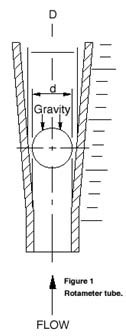Rotameter—Variable Area Flowmeter Technical InformationImportant Information on Rotameters The Variable-Area type flowmeter, or Rotameter, is one of the most economical and reliable of flow measurement instruments. In various configurations flow meters can be designed to withstand high pressures, corrosive fluids, high temperatures, and is completely independent of factors influencing electronic meters. Rotameter/Variable-Area flow meters can be calibrated to measure nearly any gas or liquid, because their principles of operation are simple and well understood. The flow indication is obtained from a balance of the fluid forces underneath the float with gravity. This is done using a uniformly tapered tube, a float whose diameter is nearly identical to the tube ID at the inlet, and a scale to correlate float height. The flow tube is traditionally placed in a vertical position and fluid enters from the bottom, forcing the float up in the tube until a sufficient annular opening exists between the float and tube to allow the total volume of fluid to flow past the float. At this point the float is in an equilibrium position and its height is proportional to the flow rate. With this in mind, many simple factors influencing flow meter performance are easily understood. For example, increasing the density and weight of the float will require a higher flow rate to force the ball up to any height in the tube. In addition, it is easy to see that any changes in the fluid caused by temperature or pressure will affect the float's position. This is particularly true for gases which are compressible, and are therefore, greatly affected by operating pressures. Studies over the years have resulted in many correlation equations or methods for correcting for gas density, pressure, temperature and viscosity. Some of the more common formulas are shown below.
General Correction Equations General correction equations for approximating gas or liquid flow from air or water flow readings:
As you can see from these equations, a pressure increase of 50 psig will more than double the flow rate indicated by the float height in a rotameter. It is important to remember that the working pressure is considered to be at the outlet of the tube when the valve is at the inlet. Conversely, if the valve is installed at the outlet, the working pressure is at the inlet. This is done to reference the operating conditions to those at calibration of the rotameter. Rotameter accuracy is dependent on the accuracy of the pressure, temperature and flow control during calibration, and operation. Gilmont flow meters are designed to extremely tight tolerances in materials. This is combined with highly accurate and precise calibration procedures which allows our meters to be rated at errors of as little as 2.0% of reading or one scale division. It should be pointed out that this is significantly better than many of our competitor's meters which are rated to no better than 5.0% "Full Scale". This simply means that for a unit with a Full Scale flow rate of 1000 sccm, the readings from this meter are no better than 50 sccm. This is true even at 200 sccm, where the error will be 25%. This exponential increase in % error limits the useful range of the meter. A good guide when specifying a rotameter for any application is to target the upper half of the scale for your flow range. In addition, based on Dr. Roger Gilmont's extensive 30 year research we are able to correlate flows using a unique data analysis program which can correct for specific operating conditions.(GF-4000 Flow Rate Analysis Program)
|

|
Processing your request... |









































